I remember my father reading to me after I was tucked in to go to sleep. Grimm’s fairy tales were a constant favorite and I was enthralled by the stories. Also, I was amazed that those black marks on the pages somehow turned into such engrossing tales. And I was impressed that my father seemed to hear the voices as he read dialogue from villains or princesses or knights. I was hooked by the desire to read, to have access to those stories, and to hear those voices for myself.
By first grade, I was reading stories on my own. But I knew I wasn’t really reading yet. I still wasn’t hearing any of the voices that my father did. In retrospect, I was probably reading Dick and Jane, and it would have been hard even for my father to give those simple stories a dramatic reading. But I thought that when you could really read, you would hear the voices.
It took a while for me give up that misconception and realize that characters’ voices, as well as visual images of how they looked, all existed 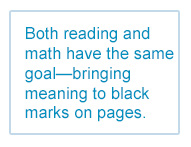 in each reader’s mind. I finally realized that I could conjure them up for myself. Now, I was truly a reader. It was up to me to bring meaning to those black marks, and I could do it. I still marvel today that those black marks not only are capable of creating stories with voices and pictures but also can give life to powerful emotions. What an achievement of humankind!
in each reader’s mind. I finally realized that I could conjure them up for myself. Now, I was truly a reader. It was up to me to bring meaning to those black marks, and I could do it. I still marvel today that those black marks not only are capable of creating stories with voices and pictures but also can give life to powerful emotions. What an achievement of humankind!
With my love of reading, majoring in mathematics seemed an odd choice. It was only after teaching for 10 years or so that I made an important instructional connection between the two. I remember in my early days of teaching thinking that I could help my students become successful because math didn’t rely on reading. We didn’t read in math class, we did math; and I presented that view to my students.
This was another misconception. And just as I can’t remember the moment that I gave up the notion that hearing voices was part of reading, I can’t recall exactly when I gave up the notion that reading wasn’t part of learning math. Eventually, I embraced the idea that both had the same goal—bringing meaning to black marks on pages. Both reading and doing math involve creating visual images. Both can engender emotions and, yes, even when doing math, I’ve experienced pleasure, delight, amusement, and also consternation, confusion, and frustration. The shift I made in my teaching was to help my students experience the full breadth of doing math. And to make that shift, I started including children’s literature in my math teaching.
My goal was to find stories that were worthy works of literature but also useful for math lessons. I’ve found books to be a way to tempt students who are generally reticent about math. They can also entice math-oriented students into the wonder of reading. I’m hooked. My collection was initially small, but I now have hundreds of children’s books on my shelves, both fiction and nonfiction titles. The suggestions below include some of my standard favorites, to give you a few ideas for connecting reading and math. Once you get started, you’ll find the possibilities are endless.
Classroom Suggestions
Here are some suggestions from time-honored classics and more current books.
- Eric Carle’s Rooster’s Off to See the World (New York: Simon and Schuster, 1972), poses a perfect problem for kindergarten children to figure out how many animals went off to see the world.
- One Is a Snail, Ten Is a Crab, by April Pulley Sayre and Jeff Sayre (Cambridge, MA: Candlewick, 2003), is a counting book that also
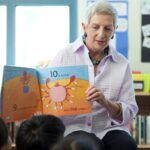 helps develop students’ understanding of place value. I’ve read the book to first, second, and third graders, and children always are delighted by it. My favorite activity is to have children write Counting Feet riddles for various numbers. They choose a number (or I choose it for them) and write a riddle based on the feet described in the book for others to figure out. In the photo below, I’m modeling a riddle for the number 11. The
helps develop students’ understanding of place value. I’ve read the book to first, second, and third graders, and children always are delighted by it. My favorite activity is to have children write Counting Feet riddles for various numbers. They choose a number (or I choose it for them) and write a riddle based on the feet described in the book for others to figure out. In the photo below, I’m modeling a riddle for the number 11. The 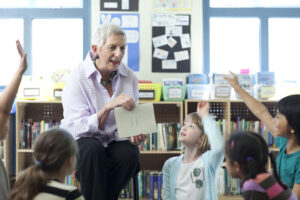 answer to my riddle is inside the folded paper, and the children are trying to guess what it is. (My answer was 1 spider + 1 person + 1 snail or 8 + 2 + 1 , but other possibilities are 1 crab + 1 snail, or 1 insect + 5 snails, 2 dogs + 3 snails, and more.)
answer to my riddle is inside the folded paper, and the children are trying to guess what it is. (My answer was 1 spider + 1 person + 1 snail or 8 + 2 + 1 , but other possibilities are 1 crab + 1 snail, or 1 insect + 5 snails, 2 dogs + 3 snails, and more.)
- Bruce Goldstone’s book Ten Friends (New York: Henry Holt, 2001) is ideal for giving students experience with combinations of numbers that add to 10. For a description about how I taught the lesson in one class, read Ten Friends: A Lesson for Second Graders.
- How Big Is a Foot? by Rolf Myller, first published in 1962 (New York: Atheneum), was one of my early finds
 and is ideal for helping students understand the reason for and benefit of using standard units when measuring lengths. I’ve used the book with second and third graders. In these photos, after reading the book to second graders, the children measured a variety of objects in the classroom. Some students found plenty of objects to measure on their desks. Two girls, however, decided to measure the tank
and is ideal for helping students understand the reason for and benefit of using standard units when measuring lengths. I’ve used the book with second and third graders. In these photos, after reading the book to second graders, the children measured a variety of objects in the classroom. Some students found plenty of objects to measure on their desks. Two girls, however, decided to measure the tank 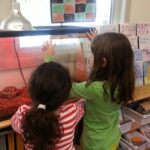 where Speedy, the class tortoise, lives. This resulted in having to add 12″ + 12″ + 10″, which turned out to be a good problem to use for a class number talk in which children shared their different strategies for adding mentally.
where Speedy, the class tortoise, lives. This resulted in having to add 12″ + 12″ + 10″, which turned out to be a good problem to use for a class number talk in which children shared their different strategies for adding mentally.
- 17 Kings and 42 Elephants, written by Margaret Mahy (New York: Dial Books for Young Readers, 1987), is a beautifully illustrated rollicking poem about a journey through a jungle. After reading the book, I suggest the problem to students of figuring out how 17 kings could share equally in taking care of 42 elephants. Perfect for third and fourth graders, the problem calls for making a decision about what to do with the remainder in a division problem.
- How Strong Is It? by Ben Hillman (New York: Scholastic, 2008), is a book with trick photographs and facts that fascinate students.
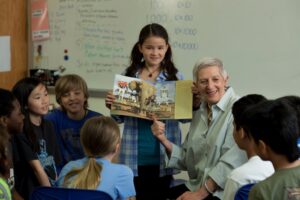 (I’ve left the book out in my living room, and my friends have been just as interested in it as children are.) For example, one photo shows an elephant using its trunk and tusks to hold up a tree trunk with four football players on it. I posed the problem to fifth graders of figuring out if the elephant could hold all of the students in the class.
(I’ve left the book out in my living room, and my friends have been just as interested in it as children are.) For example, one photo shows an elephant using its trunk and tusks to hold up a tree trunk with four football players on it. I posed the problem to fifth graders of figuring out if the elephant could hold all of the students in the class.
- Part of Laura Ingalls Wilder’s 1932 classic, Little House in the Big Woods (New York: Harper and Brothers), is perfect for a fractions lesson: in Chapter 10, Laura and Mary grapple with figuring out how to share their two cookies so Baby Carrie will get a fair share.

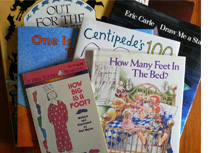
What a wonderful way to learn math, through reading fun stories! Really makes the relevancy of math come through for children. I am going to send this list to friends who have small children so that they can get started at an early age. Thank you, Marilyn.
Love this way of teaching. It would be great if we could put a comprehensive list together of all the books teachers are using in the classroom to integrate math through literature. Anyone game?
A terrific idea. Here are links for getting started. Math Solutions Math & Literature children’s books has 120 titles and Math Reads has 125 titles. There is some overlap between the two lists, but there are plenty for a start. And I’ll keep posting about others of my favorites.
Thank you Marilyn for bringing the visual to to forefront of math. This affirms to me that, yes, even I can become more proficient at math! I am a highly visual/audio person, and through visualizing the problem, and being able to hear the ‘voices’, I am more confident in my ability to comprehend mathematics.
Thank you so much for the links! It takes a village!
Your examples of using literature to understand math is so much fun. I think kids learn so quickly when the process is FUN!
Marilyn I met you first when you presented for CIME with Leonard Warren in California. You were teaching us Common Core Math Standards then. You have always been my mentor and continue to be. I’m so glad you are doing these blogs. Thank you for all the wonderful user friendly materials. You have improved my math instruction and strengthened my own math skills. Bravo
I used many of the same books in my teaching. There are books for every part of the math curriculum. Children really love to see how and why math is important in life.